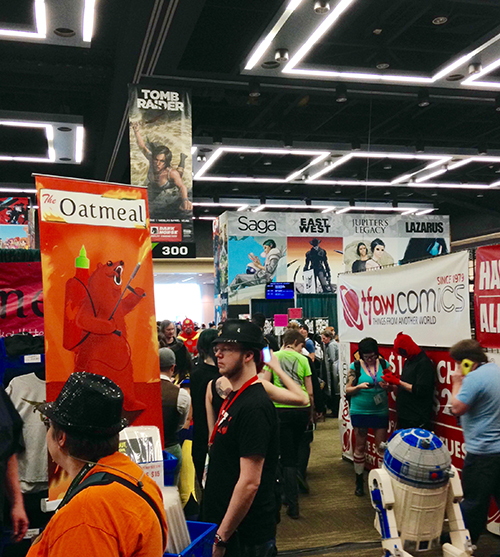Within just a few weeks of each other, two comics-related events were held this spring in Seattle and Portland, offering different opportunities for fans and creators alike to celebrate nerd culture and embrace comic art and illustration. As a comics fan and editor, I was excited to have easier access to comics conventions after moving to Portland for the Book Publishing program, including Emerald City Comicon and Linework NW. I attended each event this year with different goals and expectations, but I was still surprised by how shows that cater to a common medium varied so greatly in audience and mood.
ECCC, held March 27–29 in Seattle, has quickly grown into one of the largest comics conventions in the country, attracting more than 50,000 guests annually to the Washington State Convention and Trade Center for panels, gaming, a show floor featuring comics creators, and celebrity guests. Linework, held April 18–19 in Portland, is a young event—this was just its second year—and hosted about 2,500 guests over the weekend in a packed Norse Hall ballroom of illustrators, cartoonists, and independent publishers.
As a publishing student and comics editor, my approach for these events probably differed from many attendees’. I went into ECCC with professional goals and plans to meet certain editors and creators, as well as to encourage promising creators in Artist Alley to consider submitting to Ooligan Press in the future. I applied for and received a weekend Pro Pass based on my editorial work rather than buying a three-day pass, which would have cost $85. While I was successful in meeting the people I wanted to and handed out some Ooligan cards to writers and illustrators, the nature of the convention made it a difficult place to focus on professional work.

The Emerald City Comicon show floor.
The sheer size of the show floor—which spanned two giant rooms—and the fact that I needed a map to find the people I was looking for added an extra level of stress to the day. Shuffling slowly among the crowds, I saw thousands of cosplayers and more than a few robots perusing the floor, and just about all of them seemed to be more in their element than I was. At the end of the day, I felt successful but exhausted, and when I returned home to Portland, it took me a few days to recover and feel ready to “make comics” again. I think part of this stems from my introverted nature, but also from the format of ECCC, which is primarily a show that allows fans to celebrate their hobbies and meet their idols.
Just three weeks later, back in Portland, I felt refreshed and prepared to take on another event, but this one had a very different feel. Linework is billed as an “illustration and comics festival,” where the focus is not so much on the fan culture surrounding comics but on highlighting the work of independent comics publishers, creators, and illustrators. I also decided to take a different approach to this event, focusing on enjoying and supporting the exhibitors instead of trying to conduct any business of my own. The fact that none of my current collaborators were at Linework certainly also contributed to that decision.
The experiential difference between Linework and ECCC was clear before I even walked through the door. I had arrived at ECCC two hours early to find close parking, get my pass, and wait in line for the show floor. I arrived at Linework forty-five minutes early and ended up being one of the first people through the door, which meant that aside from free admission, I also received a swag bag full of goodies donated by local comics shops, publishers, and vendors.

A Linework NW exhibitor chats with an attendee.
The Norse Hall is a small but beautiful venue, and where huge vinyl banners promoting publishers had hung over the ECCC show floor, Linework proceeded beneath an array of Scandinavian flags. I didn’t see any cosplayers this time, but the room was still crowded, and I again shuffled through slowly. Instead of handing out cards and making professional connections, I tried to have short conversations with exhibitors—learning about what they do instead of talking about my own projects. I even came home with a huge stack of new reading materials, including zines, handmade mini-comics, and even a concertina. Partly because of the size of the event and partly because I had homework, I only stayed at Linework for a couple of hours, but when I made it home, I felt energized and excited by the work I’d seen, and I carried that feeling into my editing.
I don’t think either one of these events was better than the other, but they do offer comics fans and creators uniquely different experiences. For me, those experiences were heavily informed by my goals in comparison to those of the other attendees. I plan to attend both events again next year, but now I have a better idea of what to expect from each, professionally and personally.

